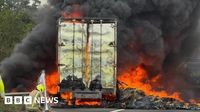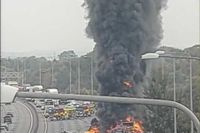On August 13, 2025, one of the UK’s busiest motorways, the M25, was brought to a standstill after a dramatic lorry fire sent thick, black smoke billowing skyward and forced the closure of a major stretch of road. The incident, which unfolded just after midday, quickly became a logistical nightmare for thousands of motorists and a major challenge for emergency services, as reported by BBC and other outlets.
The fire broke out at approximately 12:25 BST on the anti-clockwise carriageway between junction 31 at Thurrock and junction 29 for the A127, near the Lakeside Shopping Centre and the A13. According to Essex Police, the lorry involved was transporting rubber car tyres—a hazardous load that fueled the blaze and produced an extraordinary volume of smoke visible for miles around. Essex County Fire and Rescue Service later confirmed, “The lorry is carrying tyres, which are alight and are producing large amounts of smoke.”
Within minutes, the motorway was shut in both directions. Motorists heading both clockwise and anti-clockwise found themselves trapped in mounting queues, with traffic quickly backing up between key junctions. National Highways issued a statement on X (formerly Twitter): “The #M25 is now closed in both directions between J30 (@DartCharge) and J29 (#Romford) due to a HGV fire. @ECFRS remain working on scene to tackle the blaze. There are delays of at least 60 minutes on the anti-clockwise carriageway.”
Eight fire appliances from Essex, Kent, and London responded to the emergency, with dozens of firefighters working tirelessly to contain the inferno. Images from the scene showed towering flames engulfing the lorry as tyres burned intensely, sending plumes of black smoke high into the air. The fire’s proximity to the Thames crossing—a vital link connecting Kent and Essex—compounded the disruption. The Dartford Crossing, comprising a bridge and two tunnels, is used by up to 180,000 vehicles on its busiest days, according to The Independent.
As the fire raged, National Highways and Essex County Fire and Rescue Service coordinated efforts to manage the scene and keep the public informed. A diversion route was swiftly established, with travelers advised to join the A13 towards Tilbury, then take the A128 towards Brentwood, before rejoining the M25 via the A127 towards London and Stansted. Despite these efforts, delays of at least one hour were reported on the anti-clockwise carriageway, and even the clockwise lanes saw partial closures and significant slowdowns.
Firefighters managed to bring the blaze under control after several hours, but the aftermath posed yet another challenge. The intense heat from burning tyres had severely damaged the road surface and barriers, necessitating urgent repairs before the motorway could safely reopen. As Essex County Fire and Rescue Service explained, crews remained at the scene to extinguish hotspots and monitor for flare-ups, while highway engineers assessed the extent of the damage.
By 14:00 BST, the clockwise carriageway was reopened, offering some relief to stranded motorists. However, the anti-clockwise stretch between junctions 31 and 29 remained closed overnight. National Highways announced, “Due to the nature of the fire, it is still anticipated that the road will remain closed throughout the day, with resurfacing likely to be required.” Indeed, the closure lasted more than 17 hours, with the anti-clockwise side finally reopening at 06:00 BST on August 14 after extensive repair work.
Despite the scale and intensity of the fire, there was a collective sigh of relief as Essex Police confirmed that no injuries had been reported and no arrests were made. The suspected cause of the blaze, according to police, was a vehicle malfunction—a reminder of the risks associated with transporting flammable materials on busy motorways.
For many, the incident underscored just how vital the M25 is to the UK’s transport network. Approximately 250,000 motorists use the motorway daily, making it Britain’s busiest road. The sudden closure not only caused headaches for commuters and long-haul drivers but also highlighted the importance of rapid response and coordination among emergency services. As one social media user observed, “Huge fire #M25 anti clockwise between 29 and 30, possibly a lorry, lots of fire engines and police have passed.”
Throughout the ordeal, updates from Essex County Fire and Rescue Service and National Highways kept the public informed, with regular advisories to avoid the area and take extra care if traveling nearby. The fire service’s spokesperson summed up the situation: “We are dealing with a lorry fire on M25, clockwise between junctions 29 and 30. Crews from Grays (two), Basildon, Brentwood and colleagues from London Fire Brigade and Kent Fire and Rescue Service are in attendance. The lorry is carrying tyres, which are alight and are producing large amounts of smoke. Please avoid the area if you can and take extra care if you are near the scene.”
Even after the flames were doused, the recovery process was painstaking. Firefighters cooled down the scene to prevent reignition, and highway crews worked through the night to resurface damaged sections and repair barriers. The closure, which stretched from Wednesday afternoon into Thursday morning, was a stark reminder of how a single incident can ripple across a national infrastructure system, affecting countless lives and businesses.
Looking back, the coordinated response of multiple fire and rescue services, police, and highway authorities was instrumental in preventing injuries and minimizing further disruption. The swift establishment of diversion routes and transparent communication helped manage public frustration, though the scale of the disruption was hard to underestimate—especially for those caught in the gridlock or relying on timely deliveries across the region.
As traffic began flowing again on the morning of August 14, many commuters expressed both relief and gratitude for the efforts of emergency crews. The incident, while disruptive, ended without tragedy—a testament to the professionalism of the responders and a reminder of the unpredictability that comes with keeping Britain’s roads moving.





